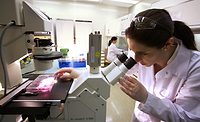The importance of a sound environmental monitoring program cannot be overstated. “If microbial growth niches are established in the processing environment, finished product contamination is inevitable,” notes Anita Kressner, Director of Product Marketing with BioControl Systems, Inc., a worldwide leader in industrial microbiology testing and hygiene monitoring. Such product contamination may result in reduced shelf life, pathogen contamination, or the product exceeding microbiological specifications. At “best,” this is an economic headache for a processor, who may have to pull or rework the product; at worst, it is a potential food safety hazard to the consumer.
With this in mind, it is important that food manufacturers regularly monitor the plant environment so corrective action can be taken before a problem arises. By employing test and sampling methods that are at the forefront of technology, any plant can institute a beneficial environmental monitoring program.
Start by Monitoring your Sanitation Effectiveness
Monitoring a plant’s sanitation process is a crucial component of an environmental monitoring program. The plant environment is not a constant, it is always in flux, says Kressner. Using an ATP bioluminescence system such as the LIGHTNING MVP enables a processor to verify sanitation effectiveness on a daily basis and instantly identify “hot spots” where microbiological testing should be done. “Depending on size of the plant, the quality assurance manager should identify multiple sampling sites on each line to be tested in a rotating fashion and randomly select a pre-determined number of these sites each day for testing with the LIGHTNING MVP. When you look at those test points over time, you’ll see which ones repeatedly have higher ATP levels than the others.” Incorporating these sites into a plant’s microbiological sampling plan makes good sense.
Based on this type of usage, she stresses the importance of selecting an ATP system on which you can depend. Many systems suffer from issues such as sanitizer interference or require refrigeration of their swabs. This gives rise to variability, which makes the development and adherence to an environmental monitoring system difficult, if not impossible. Due to these concerns, developing a chemistry to neutralize the effect of sanitizers was a key goal in the development of the LIGHTNING MVP sampling devices. This ensures accurate and consistent readings on which an organization can confidently base their monitoring program.
Another variable in ATP testing that can affect the quality of a hygiene monitoring program is swab storage. Most swabs have a shelf life between 6-12 months when refrigerated. If they are inadvertently left at room temperature most swabs lose their effectiveness and will show variations in readings. It can be difficult to control storage temperatures during shipment and even within a plant. To decrease this variability BioControl developed ATP swabs that can be stored at room temperature for up to one year, increasing test result dependability and the effectiveness of their customer’s hygiene monitoring programs.
On To Microbiological Sampling
Once a microbiological sampling plan has been established that includes hot spots identified by ATP testing and other targeted areas, attention should be paid to how samples are collected and tested. Improved technology incorporated into ready-to-use swabs can result in cost and labor savings as well as increased plant safety. Using a collection device such as BioControl’s AssureSwab eliminates the need to make media and fill glass vials.
Additionally, the risky practice of taking glass tubes out onto the manufacturing floor is eliminated. “Our environmental swab is prefilled with Letheen broth, an effective neutralizing and buffering agent,” Kressner explains. Letheen broth facilitates the recovery of bacteria and neutralizes common sanitizers remaining on surfaces after cleaning that can mask the presence of micoroganisms, making it ideal for environmental monitoring.
Once the sample is taken, advises Kressner, an important point in pathogen detection is to select a method developed and independently validated specifically for environmental samples, such as BioControl’s VIP and Assurance EIA for Listeria. These two methods have been AOAC Official Method validated specifically for environmental samples. Typically, environmental samples have a much higher bioburden of both target organisms and competitors. It is a misconception for the quality assurance lab to think that they can take the same test kit and enrichment protocol they use for finished product testing, use it for testing environmental samples and still get good results. If the wrong protocol is used, competing organisms may crowd out the target, giving rise to false negatives.
A well-designed environmental monitoring program will incorporate a combination of key parameters, such as monitoring ATP levels in conjunction with definitive microbiological analysis to gauge the effectiveness of the sanitation program and to ensure a food product’s safety and quality.
www.biocontrolsys.com



